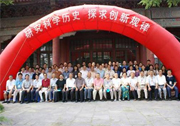| 中文题目: | 印刷术起源新论 | ||||||
| 英文题目: | Revisiting the Origin of Printing: Birthplace, Time, and Social Factors | ||||||
| 作 者: | 辛德勇 | ||||||
| 刊物名称: | Chinese Annals of History of Science and Technology | ||||||
| 发表年度: | 2021 | ||||||
| 卷: | 5 | ||||||
| 期: | 1 | ||||||
| 页码: | 90–108 | ||||||
| 中文摘要: | 通过对相关文物及论述的重新检视,提出韩国庆州佛国寺所出《无垢净光大陀罗尼经》是不可能刻印于朝鲜的,也不能作为朝鲜发明雕版印刷术的依据。根据唐代最早雕版印刷的陀罗尼经咒,可以推测出印刷术产生的时间上限为唐玄宗开元年间。印度瑜伽密教的入华及其社会大众间的广泛传播,正是促使印刷术产生最重要的社会因素,并促成了在复制经咒时,从分块捺印向整版雕印、从印制梵文向汉文的演变。 |
||||||
| 英文摘要: | A re-examination of the artifacts and research pertaining to woodblock printing reveals that The Great Dharani Sutra of Immaculate and Pure Light (Mugujeonggwang Daedaranigyeong 无垢净光大陀罗尼经) in the Seokgatap Pagoda at the Bulguksa Temple, Gyeongju, South Korea unlikely originated in Korea and therefore cannot corroborate the claim that Korea is the birthplace of woodblock printing. It can be inferred from the earliest woodblock-printed Dharani sutra, dating from the Tang dynasty, that printing was invented no earlier than Emperor Xuanzong’s Kaiyuan era (713–741). The most significant social factor for the invention of woodblock printing is the transmission of Yoga Esotericism from India to China, where it prevailed and prompted the evolution of duplicating sutras from separate-plate stamping to woodblock printing using a whole block and from the Sanskrit prints to the Chinese ones. |
||||||





